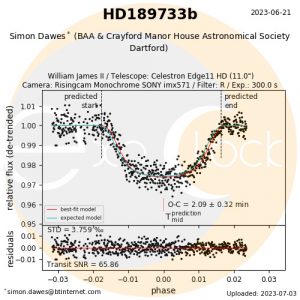Another set of observations for the ExoClock project by member Simon Dawes 🙂
Simon wrote ”This was a tricky observation, a bright star with faint comparisons, on the night of the summer solstice – the worst night of the year for astronomy, due to the lack of real night – there were 627 15s exposures which, when processed, works out at about 60Gb of disk space – for a single O-C measurement!”

”This far-off blue planet may look like a friendly haven – but don’t be deceived! Weather here is deadly. The planet’s cobalt blue colour comes from a hazy, blow-torched atmosphere containing clouds laced with glass. Howling winds send the storming glass sideways at 5,400 mph (2km/s), whipping all in a sickening spiral. It’s death by a million cuts on this slasher planet!” Ref:https://exoplanets.nasa.gov/exoplanet-catalog/6876/hd-189733-b/
HD 189733b is an exoplanet approximately 64.5 light-years away in the constellation of Vulpecula. The planet was discovered on October 5, 2005. HD 189733b orbits its host star once every 2.2 days.
The closest transiting hot Jupiter to Earth, scientists have extensively studied the exoplanet’s atmosphere. Researchers have found that the planet has an unusual rain of molten glass.
